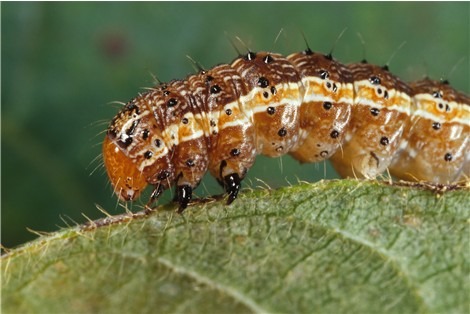Provivi, a Santa Monica-based agtech company, has raised $85 million in Series C funding co-led by Pontifax Agtech and Singapore state fund Temasek. New investor Tybourne Capital Management and existing investors Kairos Ventures, Spruce Capital, Lanx Capital, and BASF Venture Capital also participated in the round. Pontifax is investing out of its new fund, which recently held a first close on $140 million.
Provivi produces pesticide alternatives for farmers based on insect pheromones. Pheromones are naturally-occurring chemicals that animals secrete to find one another for mating. Applying specific pheromones to a field confuses the pests and prevents them from finding one another. The result is a non-toxic pest management system that is preventative in lieu of a chemical-based approach that is reactive to pest infestations that have already likely caused crop damage. And unlike chemical pesticides that kill a wide variety of living organisms, the pheromones are only relevant to the specific pest species for which they’ve been tailored.
Provivi will use the new funds to commercialize a direct-to-farmer product to combat fall armyworm. It currently provides pheromone pest management products to other businesses that serve the orchard industry where the technology has been used for over thirty years in high-value crops like apples and grapes.
Pest management is one of the most challenging aspects of crop production for farmers around the world. Chemical pesticides have been the primary tool that farmers have used to thwart infestations, but the widescale use of these often harmful products has created serious problems for agriculture’s impact on the environment.
“At the end of the day, they kill the pest and because they are toxic to the pest, they can be overcome by resistance. Once you have resistance, most farmers spray more of the same product, which is exactly what you shouldn’t do because it can reduce biodiversity in the field,” Pedro Coelho, co-founder and CEO of pheromone pest management startup Provivi told AFN.
“Regulatory and consumer-driven pressures, coupled with growing pest resistance, necessitate alternatives to traditional chemical applications in crop protection markets. Provivi’s pheromone technology provides growers with a disruptive crop protection technology that directly addresses these needs,” said Dr. Philip Erlanger, co-managing partner of Pontifax AgTech in a press release.
With so many win-win attributes, it’s difficult to imagine why pheromones have only experienced widespread adoption in orchard production, especially in light of the high market value of commodity crop production in the US and beyond.
“That’s precisely the question we asked at the beginning of 2014 when we committed Provivi to work on pheromones,” Coelho said. “We asked why everyone wasn’t doing this for row crops and the answer is that it’s too expensive and therefore adoption was limited to niche markets. The second issue is that they are volatile compounds like perfumes in a sense, so the delivery approach is very important. They are a preventative measure so they have to be in the field all the time but they can evaporate. Scaling up application and delivery is a challenge in itself.”
As a chemist, however, Coelho describes these challenges as solvable chemical challenges. Provivi is the first startup to plant its flag in the unexplored row crop pheromone pest management space and it aims to tackle both challenges by hiring the best talent around. It’s invested in technologies to help solve some of the scaling challenges while bringing down product cost to make solutions affordable for farmers, such as licensing a powerful chemical reaction technology from CalTech and MIT. Exploring different approaches to formulation and ensuring farmers have a sprayable product that is easy to apply has also been a priority.
There’s also the fact that most row crop farmers have not heard of pheromones, Coelho adds. With the commercialization of its forthcoming product, however, Provivi is hoping to change that.
There are a few other players in the pest management pheromone space including Japan’s Shin-Etsu, France’s M2i, and Syngenta-backed Danish startup BioPhero. Most of these companies are providing solutions for specialty crops and using fermentation to achieve their pheromone concoctions. The practice also involves developing a specific pheromone for each pest type to appeal to their individual mating practices.
These issues are similar to problems being faced in the broader biological inputs market. Dealing with living organisms is a lot tougher than chemical inputs that can be stored more easily and that are less sensitive to temperature fluctuations. Chemical inputs are also easier to produce at a mass scale compared to the more complex processes involved in creating microbiome- or pheromone-based solutions.
For Coelho, however, the trickiness of these challenges is far out shadowed by the enormity of the global corn market that awaits new solutions for pest management.
“When we chose to work on this pest back in 2015 it was already a key pest of corn in all of Latin America. In 2016, it arrived in West Africa specifically Nigeria. In 2017 it was in Kenya and in 2018 it was in India and Bangladesh. Now, in 2019, it has finally arrived in China, Indonesia, and Vietnam,” he explains. “The FAO has already declared it the most important corn pest and a key concern of farmers. It’s a problem for which we have a very good solution.”
The fall armyworm is also present in the US, but because most American corn is grown in temperate climates with serious winters, the tropical-loving pest doesn’t thrive to the same extent as it does in more humid regions. US corn farmers have their own nemesis in the corn rootworm, which is actually a beetle.




